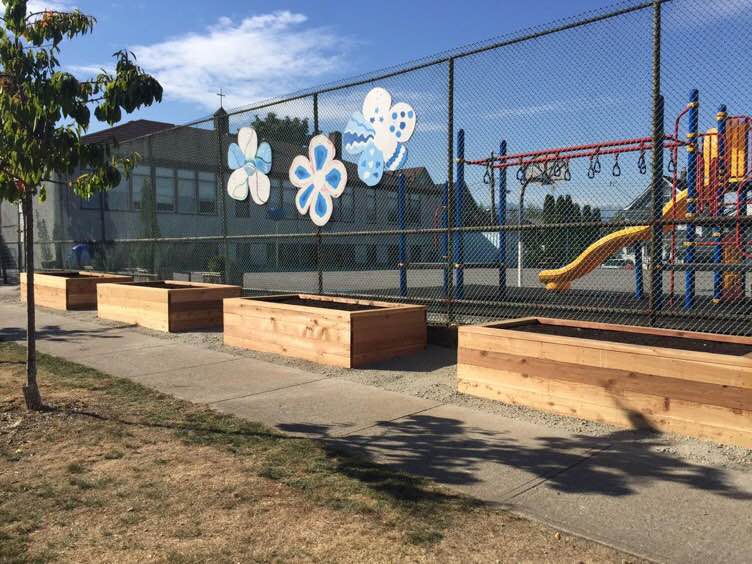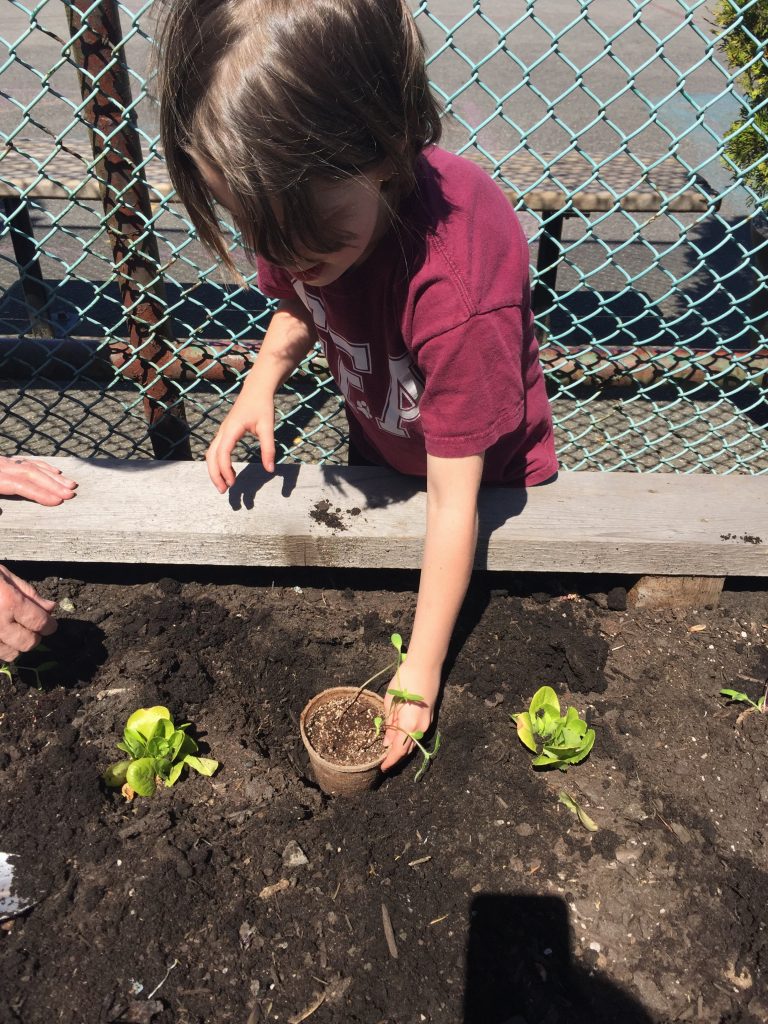Two years ago, a vision was hatched for a new program at my daughter’s school. It was to begin agricultural programming that would transform the community into a learning space about local food systems. St. Francis of Assisi School was the perfect location to begin such a program because it stood as a lone concrete lot among the oasis of urban agriculture that is the Grandview Woodlands neighbourhood.
What this school lacked in green space, however, it more than made up for in courage and imagination. I approached the administration about applying for the Farm to School BC grant. Although this was a relatively unfamiliar initiative for the school, they immediately saw the value and the vision began to take shape. A committee was formed, the staff was consulted and the journey began.
 It was decided almost immediately that any foods program for this school needed to be launched through a garden program. The reasons for this were varied; but mostly they involved issues in and around facility.
It was decided almost immediately that any foods program for this school needed to be launched through a garden program. The reasons for this were varied; but mostly they involved issues in and around facility.
The school lacked any acceptable food-preparation space. The building is over 70 years old without a gym or music room and is scheduled for replacement in the next five years. The notion of investing in a space for foods programming did not make sense. The nearby parish kitchen was considered, but was not approved as an acceptable space.
Knowing that inside programming was going to limited, the committee looked to the outside and decided a boulevard garden would be the perfect place to start. Many neighbours had already put in boulevard gardens and the school’s new ones would both compliment the neighbourhood and invite the community to engage.
The committee had originally intended for the raised garden beds to be built by a team of volunteers; however, as it was getting late in the school year and parents would soon be leaving for the summer it was decided that a local landscaping company would be hired instead. In August of 2015, Kevin and the crew from Trilogy Landscaping put in the much-anticipated garden beds. When the students and parents returned to school on September 8th, they were greeted with the gorgeous new beds and the community buzz about food and garden education began.
Since St. Francis is a Catholic school, it was important that the garden be blessed. On October 2nd, the students, staff, parents and committee members gathered with Father Gino to bless the garden. Songs were sung, prayers said and the garden was planted with its first plants. It was a lovely and fitting way launch to the program.
The winter months were spent watching the garden space transition between seasons and planning with the students what foods they would like to see come spring. In February the spring planting began to take shape. West Coast Seeds was contacted to donate seeds and the committee gathered to discuss what foods made sense to plant. We also discussed how the seeds and seedlings would be purchased. It was decided that the school would purchase the “starter” garden and that donations from the community would be welcome to fill in the rest.
 Responsibility for the garden is a continuing challenge as it is not a big enough space for each grade to have a personal area; but it is too large a space for any one class to maintain. The Grade 5 Teacher, Mrs. Pauletto, has done an admirable job negotiating this challenge. She encouraged most classes to contribute to the garden by germinating different seeds in their classroom.
Responsibility for the garden is a continuing challenge as it is not a big enough space for each grade to have a personal area; but it is too large a space for any one class to maintain. The Grade 5 Teacher, Mrs. Pauletto, has done an admirable job negotiating this challenge. She encouraged most classes to contribute to the garden by germinating different seeds in their classroom.
Some examples of this include Grade 1 growing peas and Grade 4 growing pumpkins. The school’s Social Justice club has also contributed several plants. This approach is gradually building a garden “commons” which is ensuring as many students as possible feel connected to the garden and have access to the food it produces.
To date the garden has been planted with peas, beans, lettuce, rosemary, lavender, tomatoes, onions, pumpkins, grapes and a “berry patch” where strawberries and blueberries are growing. There has also been thought put into attracting pollinators so some classes are growing flowers. The students are excited watching the garden grow and the surrounding community regularly stops into visit with the garden. Countless informal “lessons” have happened as various visitors discuss its contents. Soon the students will taste their first harvest!
Maintaining the garden has been a collaborative process between students, staff and the parents. Students do the majority of the work; however, weekend and summer maintenance have been incorporated into the school’s well-established “Parent Participation Program”. Parents have already come forward to assist this summer overcoming a major school garden hurdle – summer maintenance.
The garden has also infused food into other areas of the school. For example, this year for “Earth Day” to compliment the traditional activities, the school added a food component. They contacted SPUD Organic Food Delivery and asked them to provide some locally grown food to distribute to the classes. Next year, SPUD will be delivering a basket of food per month to a class. The teacher of that class will order food they believe aligns with the class’ curriculum and/or interests and the class will have a lesson and/or unit about it.
In the few short months since this process began, food literacy has moved from a remote idea into stimulating enrichment for student learning. The potential for the program grows each day, as does student awareness. Exciting, indeed!




As the school principal, the effect of the garden on the students has been incredible. The excitement in their voice, as they report a new strawberry growing; the sense of accomplishment on their face, when they help to water the garden. This garden is truly “sowing love” at St. Francis of Assisi School!